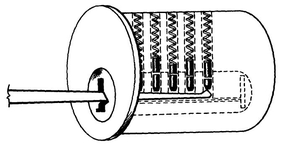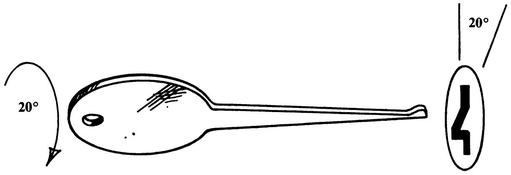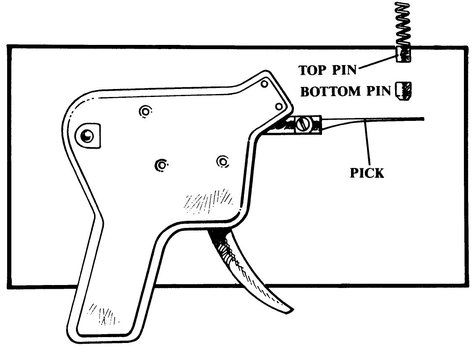Tips for Success
You will undoubtedly encounter a pin tumbler lock in which there will be a pin or two that is keyed too low (the shear line of the pin is too high). In this case the lock is difficult to open because the breaking point of a long bottom pin doesn’t allow room in the keyway for the pick to manipulate the other pins. Your success in opening “tight” locks will depend on the skill you have developed with your tension wrench. Sometimes it helps to play with the tension wrench. Try bouncing it left and right slightly while picking, allowing some of the tumblers to drop occasionally. You may also try picking the front tumblers first or picking at random on these locks. You can tell if you have a lock that is keyed like this because your pick may get jammed during the picking process.

Figure 41. Some pin tumbler locks are tricky to pick.
After you have opened a cylinder and unlocked a lock, be sure to return it to the locked position. You will hear the tumblers click into place when this happens. Otherwise it may be difficult to unlock it with its key because the bottom pins cannot “float” like they normally would.
To tell whether or not the cylinder should go clockwise or counterclockwise when picking a tumbler lock, there is an easy rule to follow. If the tumblers (pin or wafer) will not break, or stay broken, you are going in the wrong direction with the tension wrench. There will be little or no progress with the cylinder, and few, if any, “clicks.”
Some keyways are cut at an angle (Yale, Dexter, and Schlage, for example) so you want to be sure that you tilt your pick to follow that angle while picking or your pick will get hung up. A slight twist of the wrist will compensate for this problem.
Should your fingers become tired while picking a lock, lay down your tools and shake your hands and fingers to relieve any tension. After some time the muscles in your hands will become accustomed to such activity. Practice and persistence will tone your hands and senses to the point where you will be able to pop open a cylinder in three to five seconds (that’s seconds) in total darkness. The combination of touch and sound lets you know almost a split second before you open the lock that you have succeeded.
If the lock is a well-machined one, the cylinder will feel tight and you will need a little firmer hand on the tension wrench. While picking, if any one of the pins at any time feels firm or difficult to move, chances are it’s aligned. If it feels springy, it is not.

Figure 42. Some locks require that the pick be inserted at a slight angle.
Use the shaft of the pick if you have to when working the frontal pin of a pin tumbler lock. This may save you the trouble of aligning the tip of the pick on the front pin where there is little or no support for the pick. All of the other pins allow the pick to be supported by the inside wall of the keyway.
Master keyed pin tumbler locks are generally easier to pick open because they have more than one shear line or breaking point in the pins. Master keying allows a group of locks to be controlled by a master key holder while the individual locks in that group are controlled by individual keys. Hotels and apartment complexes are usually master keyed.
There is a simple technique to open pin and wafer tumbler locks. Simply drill through the shear lines of the tumblers. This point is located just above the center of the keyway on the face of the cylinder. By doing this, though, you obviously ruin the lock and make a lot of racket. If the lock is a Medeco or some other high-security lock, you risk damage of one hundred dollars or more, so be sure you know the value of the situation before you decide to rape the lock. Use a center punch to start a reliable hole on the cylinder face and use a one-quarter inch drill bit with a variable speed drill. With a large screwdriver, turn it to unlock. The cylinder will be difficult to turn because you may be shearing the tumbler springs that have fallen down past the cylinder’s shear line.
Dead bolt locks are those mounted on a door above the knob. All dead bolt locks unlock counterclockwise with left-hand doors and clockwise with righthand doors. If you have trouble remembering this, just remember that the bolt of the lock has to go in the opposite direction of the doorjam.
Dead bolt locks are just as easy to pick open as knob locks are. They both have cylinders that can be picked open. The main difference is that dead bolts cannot be opened by sliding a plastic or metal card through to the bolt so as to work it back. In other words, they are not spring loaded. That’s why they are called dead bolts. Most knob locks now have guards in front of the bolts to deter opening with cards.
Kwik-sets, Weisers, and some of the less-expensive knob locks may open in either direction. Schlage and Corbin, along with more sophisticated locks, can open only in one direction. Auto locks will open either way. Another method of picking pin tumbler locks is with a pick gun. As the pick snaps up, it hits the bottom pin. This bounces the top pin out of the cylinder and into the shell. As you apply light turning pressure with the tension wrench, the top pins are caught in the shell, the cylinder will turn. I’ve never used a pick gun, but they do work well for locksmiths who use them. They are cumbersome and expensive, and show some lack of professionalism.

Figure 43. Pick guns are for those who can’t take the time to learn the fine art of lock picking.
On the mechanical side, there are locks that have normal pin tumblers, but they are situated in various places 360 degrees around the cylinder. Some locks use pin tumblers that not only have to be aligned vertically within the cylinder, but also have to “twist” or turn a certain number of degrees to allow the cylinder to open. This is because the pins’ shear line is cut at an angle. These locks are made by Medeco.
I have witnessed only one Medeco lock being picked—by a fellow locksmith. We both spent hours trying to pick it again, but it was futile. We estimated the chances of opening it again to be one out of 10,000. They are excellent security devices, but their price keeps them limited to areas prone to security problems such as isolated vending machines and for government use. The only one I have been successful at opening (after an hour of picking) was one I drilled. By the way, they are easy to drill because the brass that’s used is soft.
LEARNING TO TOUCH AND FEEL
Most of us know how to touch. We touch objects every day, and yet we do not truly feel them. It seems so commonplace that we forget that we are actually feeling while we touch.
Here is an exercise that will develop a delicate touch. Gently rub and massage your hands and fingers—preferably with hand lotion. Do this for five minutes. Once the lotion has evaporated, shake your hands and fingers so that they flop loosely. Gently pull each finger to relax each joint.
Now with a piece of fine sandpaper, gently draw the tips of your fingers across it. Try to feel the texture of the grains on its surface. Relax your fingers, hands, forearms, shoulders, and chest. Take your time. Do this for several minutes.
After a few weeks of practice, you will be able to feel each individual grain of sand on the sandpaper. This allows you to feel the slightest sensation vibrate through your bones.
Try to remember to practice touching and feeling during your everyday experiences. Practice feeling wood, metal, and various other objects. Play with the feel of mechanical vibrations, even your television set. Try to sense the world around you as a source of information. This could and will open a whole new horizon of experience.
After a while, you will be able to feel or sense the movement of the tumblers of a Sargeant and Greenleaf safe. My first safe opened in three minutes because of that technique that took me years to discover.
VISUALIZATION
If you respect the security of the lock and do not become overconfident, you will never become disappointed if you fail to open it. You also increase your chances of opening the lock because you personally have nothing to gain or lose by opening it. Give up trying to be an expert and just pick the lock.
With such an attitude, you may find the lock will usually pop right open. I never received a trophy for being the best lock picker in the state. My satisfaction is in knowing that I am never helpless in a lockout situation. The quality of your success is almost romantic; it involves sensitivity and compassion in the face of curiosity as a means to help others.
Visualization and imagination are important to the lock picker. I’ve noticed that people who have the ability to visualize the internal parts of the lock that they are picking seldom fail to open it in moments. Anyone can learn to do this by simply remembering to do it while picking a lock. Since sight, sound, and touch are involved with the process, visualization is very easy to do. Try to keep all of your attention on the lock during the picking process. This will help you to learn how to use heightened sensitivity for picking locks.
So in that respect, an unopened lock is like a new and unexplored lover. You imagine all of the qualities of an attractive person whom you’ve just met and apply that feeling to the lock that you are picking. Use visualization. It will help immensely.